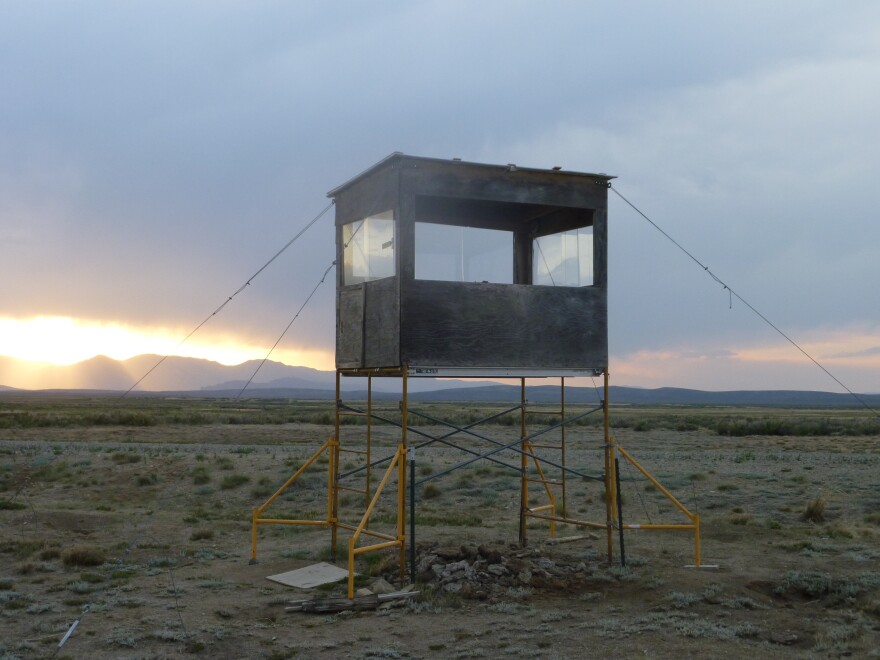Sitting in a tower on a windy evening in a remote corner of northwestern Colorado, John Hoogland is doing what he likes best: watching prairie dogs.
For the layman, this might sound as interesting as watching paint dry. But John Hoogland is a behavioral ecologist at the University of Maryland. For the past seven years he’s spent the spring and early summer in Colorado at the Arapaho National Wildlife Refuge.
“A major key to our research is we live with these prairie dogs,” explains Hoogland. “We get here at dawn; we don’t leave until they go to bed. So we get to know all their idiosyncrasies.”
Trying to understand the motivations behind those idiosyncrasies has been the thrust of his entire career. In a way, it’s been 40 years of his own “Meerkat Manor.”
"It's like studying little people, because if you have 50 prairie dogs you have 50 personalities."
“It’s like studying little people, because if you have 50 prairie dogs you have 50 personalities,” says Hoogland. “Some of them always get up early, some of them always get up late…some of them are just nasty, and fight with anything that comes anywhere near them, others are chicken and are always avoiding fights.”
Prairie dogs are especially appealing because Hoogland says they are one of the easiest social mammals to study. He first traps them and gives each a unique tag, number, and body paint design. Then he grabs his binoculars, climbs into his tower and takes notes on his clipboard.

But this has been one of the worst years for observation – due to the drought and a very successful predator, a badger Hoogland and his four assistants call Barbara. She’s taken at least 18 dogs so far.
“This badger is like a Houdini,” says Hoogland. “She can show up anywhere.”
So tonight, we’re on badger watch. The prairie dogs are, too. One of the behaviors Hoogland has examined in detail is their alarm call system. Prairie dogs generally only sound the alarm if another dog they’re related to is nearby. But some species define family member more or less generously.
“Now for these white-tailed prairie dogs, mothers with babies call, but also females with other kin will call. So if a female doesn’t have her own babies, but she does have nieces and nephews, she will call.”
But keeping a close eye on his colonies over the years, Hoogland has found that the danger for prairie dogs doesn’t just come from other species. New mothers will kill and cannibalize the infants of fellow prairie dogs.

“We had one female, we called her killer supreme because over several years she took out nine different litters,” says Hoogland. “On the surface everything seems so calm, and all they seem so kissy-kissy and lovey-dovey, but underneath that there’s this incredibly intense competition.”
Competition is also a key factor during the mating season, when the females are sexually receptive for only about five hours on a single day.
“That period of two weeks is by far, the highlight of the year,” says Hoogland. “Because there’s so much drama. The fights between those males are just titanic battles, because winner takes all. He gets the territory and he gets all the girls.”
Lately, he’s been looking at a particular phenomenon, polyandry, or females mating with more than one male. Nearly all species are polyandrous to some extent, but Hoogland says biologists for the most part have only been able to speculate about what sort of evolutionary advantages come with such a mating strategy. But Hoogland has decades’ worth of research to work from.
“We found that for females that mate with several males, they gain three clear, unequivocal advantages,” says Hoogland. “They’re more likely to conceive, they have larger litters at weaning, and their babies survive better.”
But there’s always a flip-side.
“We’ve also found that females that are polyandrous, in other words, females that mate with several males, are less likely to survive to the next year,” says Hoogland.
That makes for a trickier kind of evolutionary calculus. But it’s exactly these types of behavioral questions that keep him coming back each year.

The sun is beginning to set, and the few small dogs remaining are furiously eating some grasses before they, too, head into their burrows for the night.
“These babies, they have to gain enough weight to survive the winter, so it’s a race against time,” says Hoogland.
For right now they’re lucky—there’s been no sign of Barbara the badger tonight. When John Hoogland returns next year, he’ll find out which of them made it. And those that have will get a new coat of distinctive body paint, and he’ll get to know their personalities, too.







